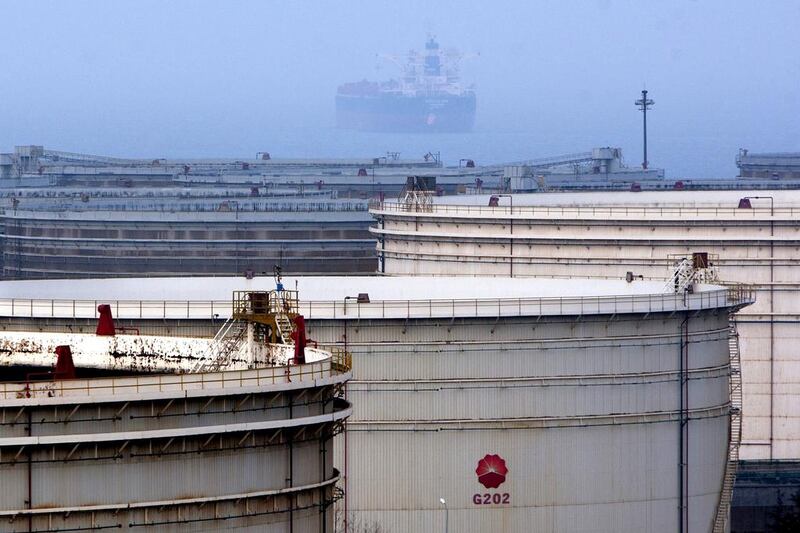The dominance of China’s state oil companies in Asian crude trading is worrying regional oil companies, which are considering changing the way billions of dollars worth of crude is priced.
The concern has been building since last year. It came to a head in August when China’s state oil companies completely controlled trading in the so-called Dubai marker crude, which is the benchmark that determines prices for the 15 million barrels per day of Arabian Gulf crude that is sold to Asia’s refiners.
For the regional producers, already suffering from the collapse in oil prices, even a small additional discount in the regional benchmark can mean hundreds of millions of dollars a month in lost revenue.
Despite recent efforts to make that benchmark harder to control, Chinaoil, the trading arm of PetroChina, China’s largest oil company, bought all of the cargoes in January that went to make up the benchmark price. Unipec, part of another Chinese state oil company, accounted for most of those sales.
Regional players such as Saudi Aramco, National Iranian Oil Company and Iraq’s State Oil Marketing Organisation, as well as some of the big private-sector oil companies and trading houses, fear China’s ability to control the Asian benchmark oil price, according to Jorge Montepeque, an oil consultant. Mr Montepeque was, until the end of last year, the head of pricing at Platts, a data company whose prices are used to set the Dubai benchmark each month.
“That concern has now grown even further and there is an emerging consensus that a balance needs to be restored,” Mr Montepeque says.
Oil trading is an opaque business largely because it is impossible to standardise the 200 or so different types of crude oil grades with different physical and economic attributes that are sold across the globe.
The pricing mechanism invented in the 1990s by Mr Montepeque for Platts, a division of the US publishing company McGraw-Hill, is meant to allow traders to price the different crudes at premiums or discounts to benchmarks. However, the system has been criticised over the years as being open to manipulation when a very big player can dominate. Such is the case with China’s huge refiners, whose combined capacity has grown exponentially since the start of the century, from about 2m barrels per day to more than 14 million bpd currently.
China has not hidden its desire to use its buying power to wrest more oil pricing control.
One indication was in evidence when the Shanghai International Energy Exchange, known as INE, invited a top delegation from Abu Dhabi National Oil Company (Adnoc) last year for a presentation about INE’s proposed new crude futures contract.
“They got to the concluding slide, which had the objective in bold: ‘Much Lower Oil Prices for Asian Refiners,’” which had the Adnoc traders exchanging anxious glances, says a person who attended the presentation. “They either forgot to change the slide or just didn’t care what [Adnoc] thought.”
China’s oil trading firms also have given no indication that they are moved by concerns about their dominance of Platts’ Asian benchmark oil prices.
In December, the head of trading at Royal Dutch Shell, Mike Muller, took the highly unusual step of going public over China’s dominance.
Also, trading houses that traditionally provide market liquidity – such as Trafigura, Vitol and Mercuria – have been pulling back from the market.
Platts responded at the end of last year by adding more qualified grades, such as Al Shaheen from Qatar, in an effort to attract more players and make it harder to control.
“But the first trade of the year – at 9am on January 4th – was Unipec selling Al Shaheen to Chinaoil,” says a trading source, asking not to be named. “It was them saying, ‘You can put all the grades you like in there but we still own the market.’”
Regulators have mostly left these types of over-the-counter energy markets alone, viewing the players as professionals who can look after themselves. But that attitude may be changing in the wake of high-profile energy market manipulation cases such as Enron – and the huge regulatory failures that led to the financial crisis
The Middle East and Asia is the least regulated of the major oil trading regions, but an obvious fix for the current situation would be for the regional national oil companies (NOCs) to use the regulated Dubai Mercantile Exchange’s Oman futures contract as a benchmark, say a number of traders, including Mr Muller.
“A major benchmark price should always be determined by a liquid futures contract,” argues Tony Nunan, an oil risk manager at the Japanese trading house Mitsubishi. “The reason you need a futures market is because it is standardised … and lends itself to participation by more players to provide more liquidity.”
The NOCs are often slow to move and a benchmark change involves a big disruption to their bureaucracy.
“There is a tremendous amount at stake and that’s why any changes to the benchmark will reverberate and there will be inertia in wanting to touch that,” says Eugene Lindell, a senior crude market analyst at JBC Energy in Vienna.
Mr Montepeque agrees: “Their contracts are very long term and relationships are forged to exist for a long time. On both sides of the fence, they do not have a great incentive [to change the benchmark] contractually or system-wide because it may trigger other reviews.”
But the NOCs’ attitudes are hardening, a sign of which was the ditching last month of Platts as Opec’s official price data provider.
“There are more months cropping up now where there is evident distortion, [and] as incidents increase the potential for change increases,” says Mr Lindell. “The key is Aramco. They have been studying this for some time now. You just need the backing of the biggest producer in the region and overnight it would change. The others would follow.”
There is precedent for a benchmark switch – Aramco ditched Platts West Texas Intermediate for another pricing service in 2009 – but the NOCs have hitherto resisted using futures markets.
The DME Oman futures exchange set a record level of open interest last month as trading volume was at its highest in more than a year, but it is still in the tens of thousands compared to hundreds of thousands of trades in London and New York oil futures.
“When I talk to NOCs they are worried about liquidity but my point is at least DME Oman has a chance to get better, whereas I don’t think Platts will,” says Mr Nunan. “If the NOCs are using it then people hedging would have to use it and it boosts liquidity right off the bat. Then it attracts the investor-speculator class and it at least has a chance to become much better,” he adds.
While a number of NOCs have been studying a switch, “the Iranians are the most serious right now”, says a market executive who has been in discussions with NIOC on the matter. “They have considered trying to use their own benchmark on the Iranian Mercantile Exchange but that’s very problematic”, especially given the sanctions history, says the executive, asking not to be named.
“It’s kind of a prisoner’s dilemma now between Saudi and Iran,” he adds.
“It makes sense for them both [to switch the benchmark] but neither one wants to go first.”
amcauley@thenational.ae
Follow The National's Business section on Twitter





